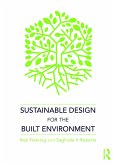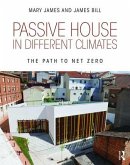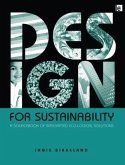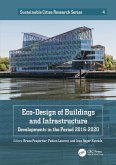Urban Experience and Design
Contemporary Perspectives on Improving the Public Realm
Herausgeber: Hollander, Justin B; Sussman, Ann
Urban Experience and Design
Contemporary Perspectives on Improving the Public Realm
Herausgeber: Hollander, Justin B; Sussman, Ann
- Broschiertes Buch
- Merkliste
- Auf die Merkliste
- Bewerten Bewerten
- Teilen
- Produkt teilen
- Produkterinnerung
- Produkterinnerung
Embracing a biological and evolutionary perspective to explain the human experience of place, Urban Experience and Design explores how cognitive science and biometric tools provide an evidence-based foundation for architecture and planning.
Andere Kunden interessierten sich auch für
![Urban Waterfront Promenades Urban Waterfront Promenades]() Elizabeth MacdonaldUrban Waterfront Promenades61,99 €
Elizabeth MacdonaldUrban Waterfront Promenades61,99 €![Sustainable Design for the Built Environment Sustainable Design for the Built Environment]() Rob FlemingSustainable Design for the Built Environment67,99 €
Rob FlemingSustainable Design for the Built Environment67,99 €![Planning Sustainable Cities Planning Sustainable Cities]() Spiro PollalisPlanning Sustainable Cities49,99 €
Spiro PollalisPlanning Sustainable Cities49,99 €![Passive House in Different Climates Passive House in Different Climates]() Mary JamesPassive House in Different Climates86,99 €
Mary JamesPassive House in Different Climates86,99 €![Meaning Making in Planning Meaning Making in Planning]() Mick LennonMeaning Making in Planning28,99 €
Mick LennonMeaning Making in Planning28,99 €![Design for Sustainability Design for Sustainability]() Janis BirkelandDesign for Sustainability66,99 €
Janis BirkelandDesign for Sustainability66,99 €![Eco-Design of Buildings and Infrastructure Eco-Design of Buildings and Infrastructure]() Eco-Design of Buildings and Infrastructure93,99 €
Eco-Design of Buildings and Infrastructure93,99 €-
-
-
Embracing a biological and evolutionary perspective to explain the human experience of place, Urban Experience and Design explores how cognitive science and biometric tools provide an evidence-based foundation for architecture and planning.
Produktdetails
- Produktdetails
- Verlag: Taylor & Francis
- Seitenzahl: 230
- Erscheinungstermin: 16. Oktober 2020
- Englisch
- Abmessung: 226mm x 152mm x 13mm
- Gewicht: 454g
- ISBN-13: 9780367435554
- ISBN-10: 0367435551
- Artikelnr.: 60000479
- Herstellerkennzeichnung
- Libri GmbH
- Europaallee 1
- 36244 Bad Hersfeld
- gpsr@libri.de
- Verlag: Taylor & Francis
- Seitenzahl: 230
- Erscheinungstermin: 16. Oktober 2020
- Englisch
- Abmessung: 226mm x 152mm x 13mm
- Gewicht: 454g
- ISBN-13: 9780367435554
- ISBN-10: 0367435551
- Artikelnr.: 60000479
- Herstellerkennzeichnung
- Libri GmbH
- Europaallee 1
- 36244 Bad Hersfeld
- gpsr@libri.de
Justin B. Hollander is a professor of Urban and Environmental Policy and Planning and director of the C.A.G.S in Urban Justice and Sustainability at Tufts University. His research and teaching is in the areas of physical planning, big data, shrinking cities and the intersection between cognitive science and the design of cities. He is the author of seven other books on urban planning and design, including Cognitive Architecture: Designing for How We Respond to the Built Environment (with Ann Sussman) and Urban Social Listening: Potential and Pitfalls for Using Microblogging Data in Studying Cities, and was recently inducted as a fellow of the American Institute of Certified Planners. He hosts the Apple podcast 'Cognitive Urbanism.' Ann Sussman is a registered architect, researcher and college instructor. Her book, Cognitive Architecture: Designing for How We Respond to the Built Environment (Routledge, 2015), coauthored with Justin B. Hollander, won the Place Research Award from the Environmental Design Research Association (EDRA) in 2016. She currently teaches a new course on perception and the human experience of place, 'Architecture and Cognition,' at the Boston Architectural College (BAC). In 2020, she founded and became president of the nonprofit The Human Architecture + Planning Institute, Inc. (theHapi.org).
Introduction: The 21st-Century Paradigm Shift in Architecture and Planning
Section 1: Historical and Theoretical Foundations of Architecture and
Planning 1 Sense of Place: Looking Backward to Go Forward? 2 Classic
Planning: The Power of Beauty for Human Architecture and Planning 3 Bonding
with Beauty: The Connection Between Facial Patterns, Design and Our
Well-Being 4 Neuroscience Experiments to Verify the Geometry of Healing
Environments: Proposing a Biophilic Healing Index of Design and
Architecture Section 2: Twenty-First-Century Tools: Biometrics and
Measuring the Human Experience of Place 5 Identifying Biophilic Design
Elements in Streetscapes: A Study of Visual Attention and Sense of Place 6
Exploring Eye-Tracking Technology: Assessing How the Design of Densified
Built Environments Can Promote Inhabitants' Well-Being 7 Attention and
Focus in the Perception of Persian Architecture Section 3 Explorations of
the New Paradigm for Urban Experience and Design 8 Cognitive Mapping,
Mobility Technologies and the Decoupling of Imageability and Accessibility
9 Emerging Transport Futures for Streets and How Eye Tracking Can Help
Improve Safety and Design 10 Ecoempathetic Design: Moving Beyond Biophilia
With Brain Science 11 Exploring Urban Form Through OpenStreetMap Data: A
Visual Introduction 12 A Device-Free Mapping Approach for Quantifying User
Activities in Indoor Environments 13 Being Seen, Feeling Heard: Designing
Intimate-Scaled Spaces on Urban College Campuses Conclusion: Understanding
Ourselves Better Reframes Architecture and Planning
Section 1: Historical and Theoretical Foundations of Architecture and
Planning 1 Sense of Place: Looking Backward to Go Forward? 2 Classic
Planning: The Power of Beauty for Human Architecture and Planning 3 Bonding
with Beauty: The Connection Between Facial Patterns, Design and Our
Well-Being 4 Neuroscience Experiments to Verify the Geometry of Healing
Environments: Proposing a Biophilic Healing Index of Design and
Architecture Section 2: Twenty-First-Century Tools: Biometrics and
Measuring the Human Experience of Place 5 Identifying Biophilic Design
Elements in Streetscapes: A Study of Visual Attention and Sense of Place 6
Exploring Eye-Tracking Technology: Assessing How the Design of Densified
Built Environments Can Promote Inhabitants' Well-Being 7 Attention and
Focus in the Perception of Persian Architecture Section 3 Explorations of
the New Paradigm for Urban Experience and Design 8 Cognitive Mapping,
Mobility Technologies and the Decoupling of Imageability and Accessibility
9 Emerging Transport Futures for Streets and How Eye Tracking Can Help
Improve Safety and Design 10 Ecoempathetic Design: Moving Beyond Biophilia
With Brain Science 11 Exploring Urban Form Through OpenStreetMap Data: A
Visual Introduction 12 A Device-Free Mapping Approach for Quantifying User
Activities in Indoor Environments 13 Being Seen, Feeling Heard: Designing
Intimate-Scaled Spaces on Urban College Campuses Conclusion: Understanding
Ourselves Better Reframes Architecture and Planning
Introduction: The 21st-Century Paradigm Shift in Architecture and Planning
Section 1: Historical and Theoretical Foundations of Architecture and
Planning 1 Sense of Place: Looking Backward to Go Forward? 2 Classic
Planning: The Power of Beauty for Human Architecture and Planning 3 Bonding
with Beauty: The Connection Between Facial Patterns, Design and Our
Well-Being 4 Neuroscience Experiments to Verify the Geometry of Healing
Environments: Proposing a Biophilic Healing Index of Design and
Architecture Section 2: Twenty-First-Century Tools: Biometrics and
Measuring the Human Experience of Place 5 Identifying Biophilic Design
Elements in Streetscapes: A Study of Visual Attention and Sense of Place 6
Exploring Eye-Tracking Technology: Assessing How the Design of Densified
Built Environments Can Promote Inhabitants' Well-Being 7 Attention and
Focus in the Perception of Persian Architecture Section 3 Explorations of
the New Paradigm for Urban Experience and Design 8 Cognitive Mapping,
Mobility Technologies and the Decoupling of Imageability and Accessibility
9 Emerging Transport Futures for Streets and How Eye Tracking Can Help
Improve Safety and Design 10 Ecoempathetic Design: Moving Beyond Biophilia
With Brain Science 11 Exploring Urban Form Through OpenStreetMap Data: A
Visual Introduction 12 A Device-Free Mapping Approach for Quantifying User
Activities in Indoor Environments 13 Being Seen, Feeling Heard: Designing
Intimate-Scaled Spaces on Urban College Campuses Conclusion: Understanding
Ourselves Better Reframes Architecture and Planning
Section 1: Historical and Theoretical Foundations of Architecture and
Planning 1 Sense of Place: Looking Backward to Go Forward? 2 Classic
Planning: The Power of Beauty for Human Architecture and Planning 3 Bonding
with Beauty: The Connection Between Facial Patterns, Design and Our
Well-Being 4 Neuroscience Experiments to Verify the Geometry of Healing
Environments: Proposing a Biophilic Healing Index of Design and
Architecture Section 2: Twenty-First-Century Tools: Biometrics and
Measuring the Human Experience of Place 5 Identifying Biophilic Design
Elements in Streetscapes: A Study of Visual Attention and Sense of Place 6
Exploring Eye-Tracking Technology: Assessing How the Design of Densified
Built Environments Can Promote Inhabitants' Well-Being 7 Attention and
Focus in the Perception of Persian Architecture Section 3 Explorations of
the New Paradigm for Urban Experience and Design 8 Cognitive Mapping,
Mobility Technologies and the Decoupling of Imageability and Accessibility
9 Emerging Transport Futures for Streets and How Eye Tracking Can Help
Improve Safety and Design 10 Ecoempathetic Design: Moving Beyond Biophilia
With Brain Science 11 Exploring Urban Form Through OpenStreetMap Data: A
Visual Introduction 12 A Device-Free Mapping Approach for Quantifying User
Activities in Indoor Environments 13 Being Seen, Feeling Heard: Designing
Intimate-Scaled Spaces on Urban College Campuses Conclusion: Understanding
Ourselves Better Reframes Architecture and Planning








